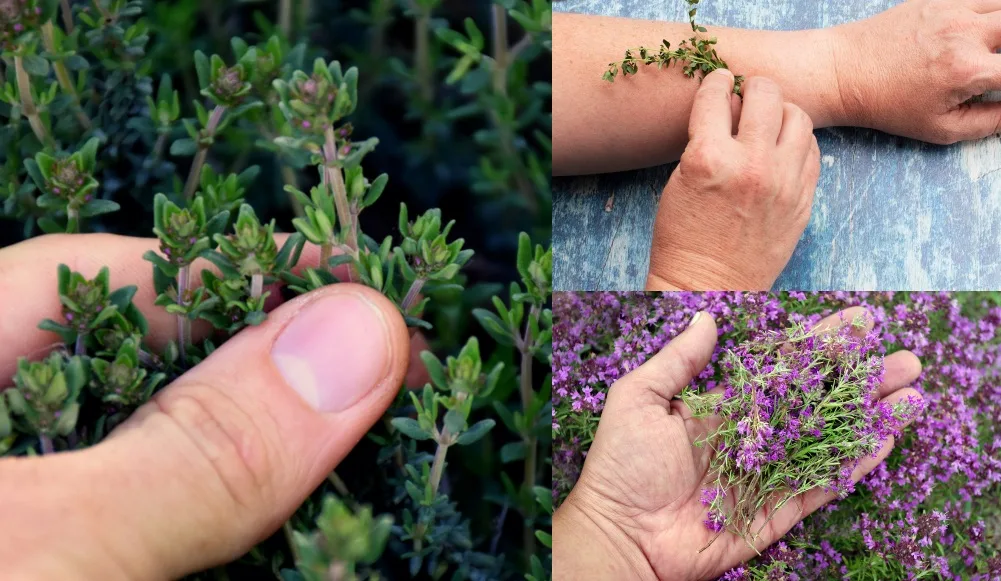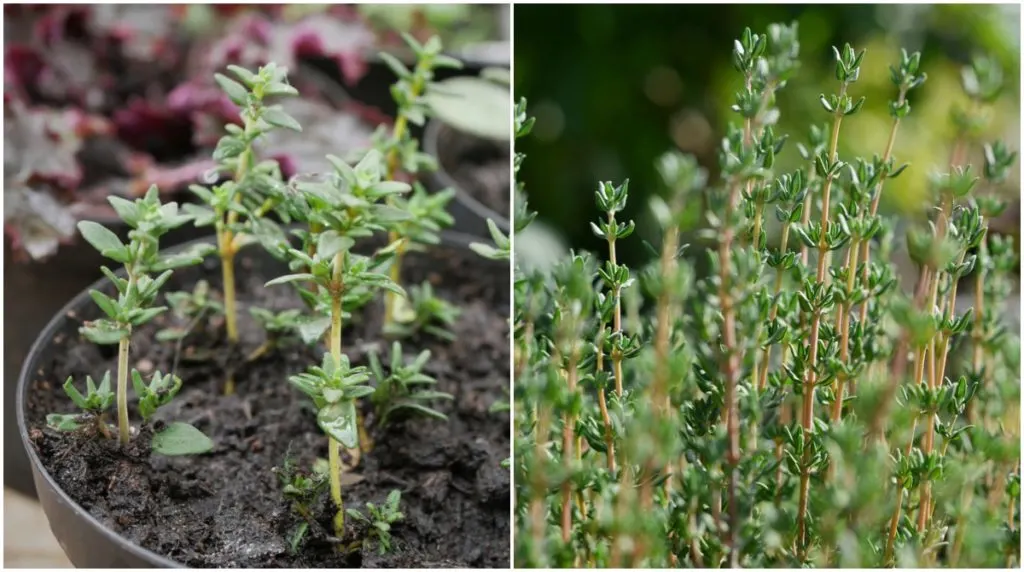
The aroma of thyme is pleasant and complex – peppery and a little sweet with woody, earthy, minty and flowery notes. Flavor-wise, it lands somewhere between lavender and rosemary.
For many, thyme perfectly encapsulates the fragrance of summertime.
About Thyme
Common thyme (Thymus vulgaris) is a woody, perennial, evergreen herb in the mint family. It’s indigenous to southern Europe and northern Africa and favors the dry, rocky soils of the Mediterranean.
Forming mounds 6 to 12 inches tall, thyme’s woody stems are clad in small pointed gray-green leaves. The attractive foliage is highly fragrant, especially just before plants begin to flower.
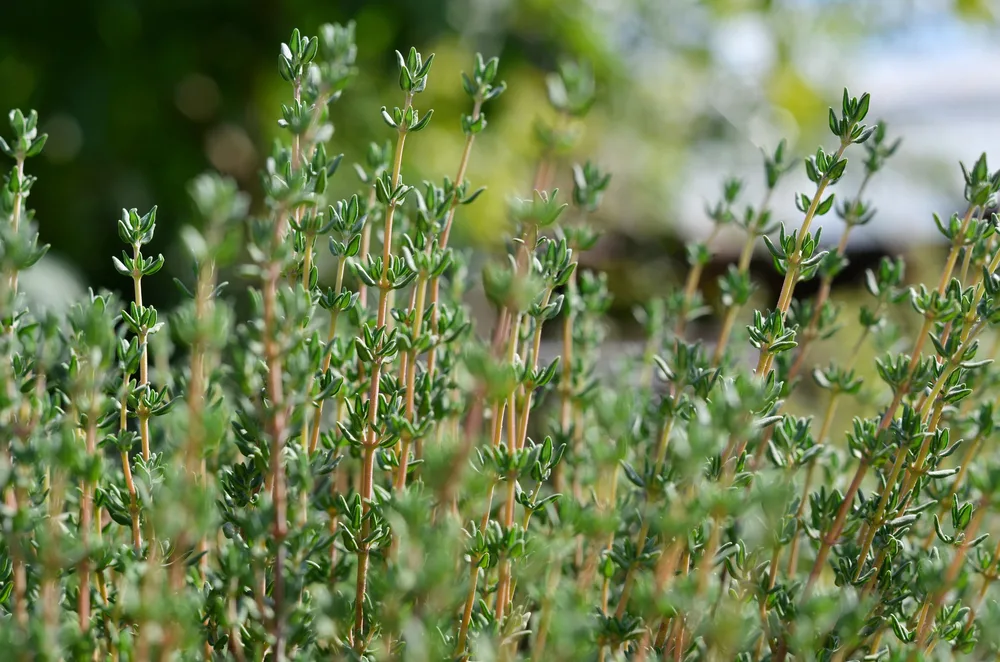
From May to July, thyme bears masses of pretty blooms in white, pink, or lavender hues. Flowers are tiny and tubular, and act as a magnet for bees and butterflies.
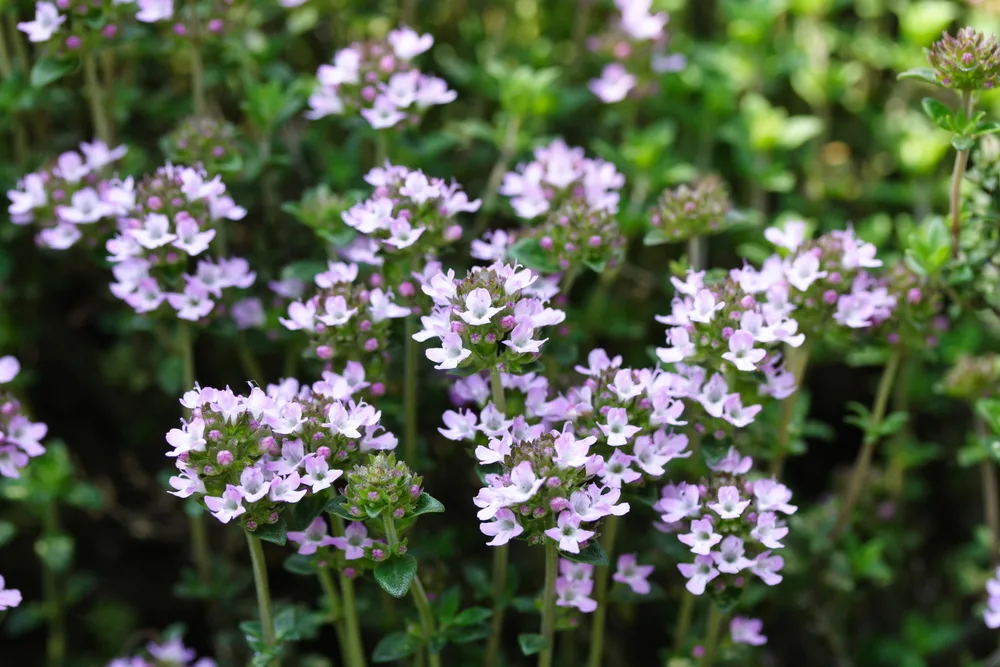
Thyme has been used for centuries as food, medicine, and fragrance. Ancient Egyptians used it for embalming, Greeks burned it as incense, and Romans for flavoring cheese and liqueurs. Due to its natural antibacterial properties, bandages were soaked in thyme oil to assist the healing process.
The origin of its name is derived from the Greek word thumos which means courage. In the Middle Ages, warriors were gifted thyme leaves before heading into battle and it was often placed on coffins to assure passage into the next life.
Varieties of Thyme
Although common thyme is the dominant culinary herb, there are more than 300 species of thyme grown mainly for their ground covering and ornamental qualities.
Here are a few more popular thyme varietals:
Lemon thyme (Thymus × citriodorus) is another delicious edible variety with strong citrus scented leaves.
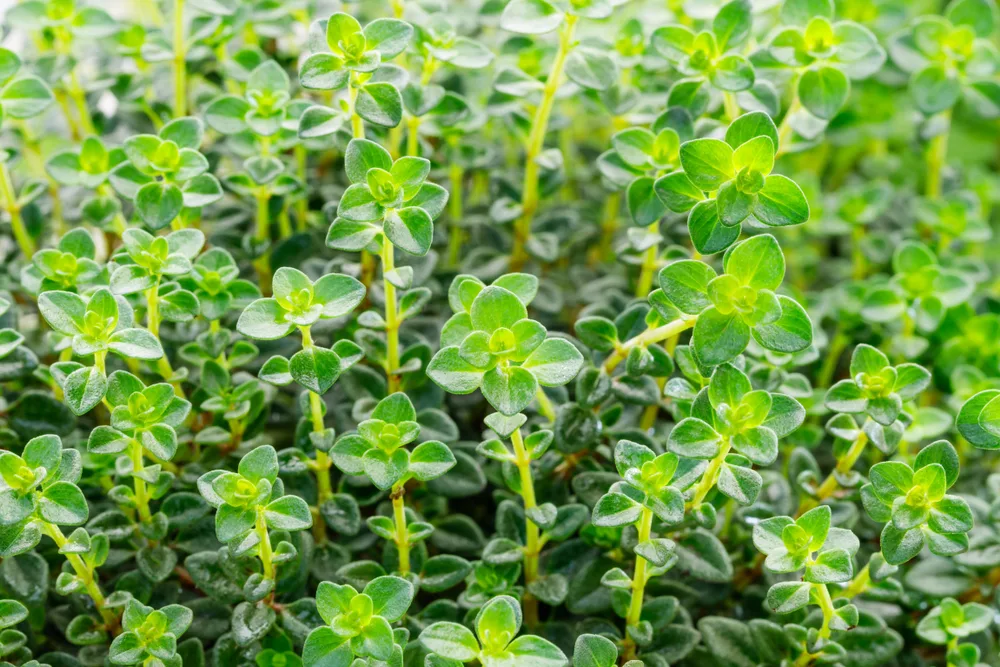
Woolly thyme (Thymus pseudolanuginosus) is a sprawling ground cover with soft and furry hairs all over the leaves and stems. Though the foliage is fairly fragrance-free, plants will bear pale pink flowers from June to July.
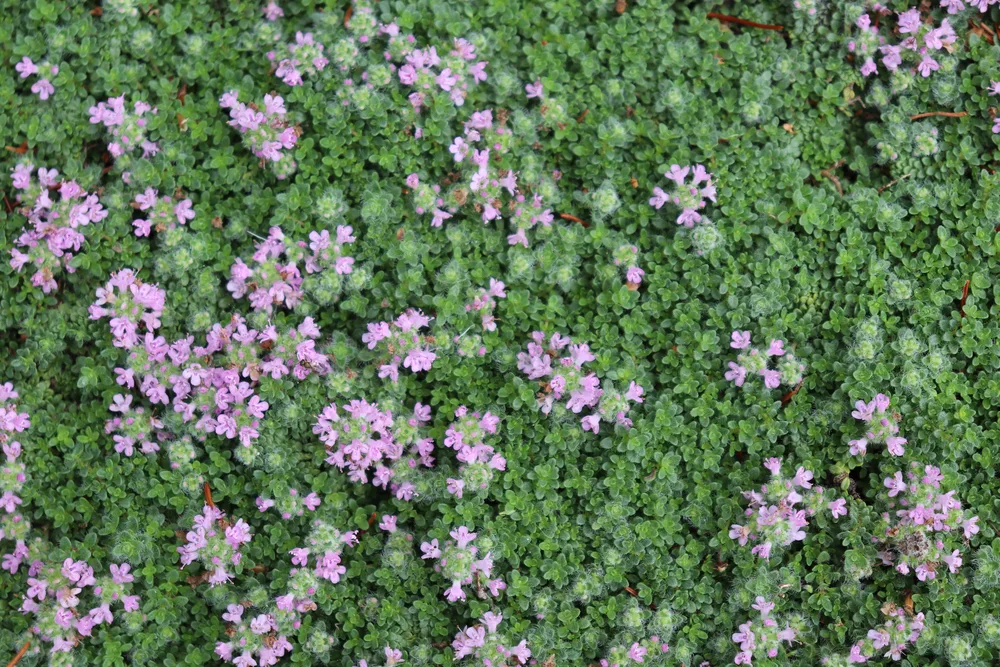
Creeping thyme (Thymus praecox) is a small, mat-forming low grower that is great as garden edging and as a filler between stepping stones. Masses of showy rose-to-lilac colored flowers top the foliage from June to September.
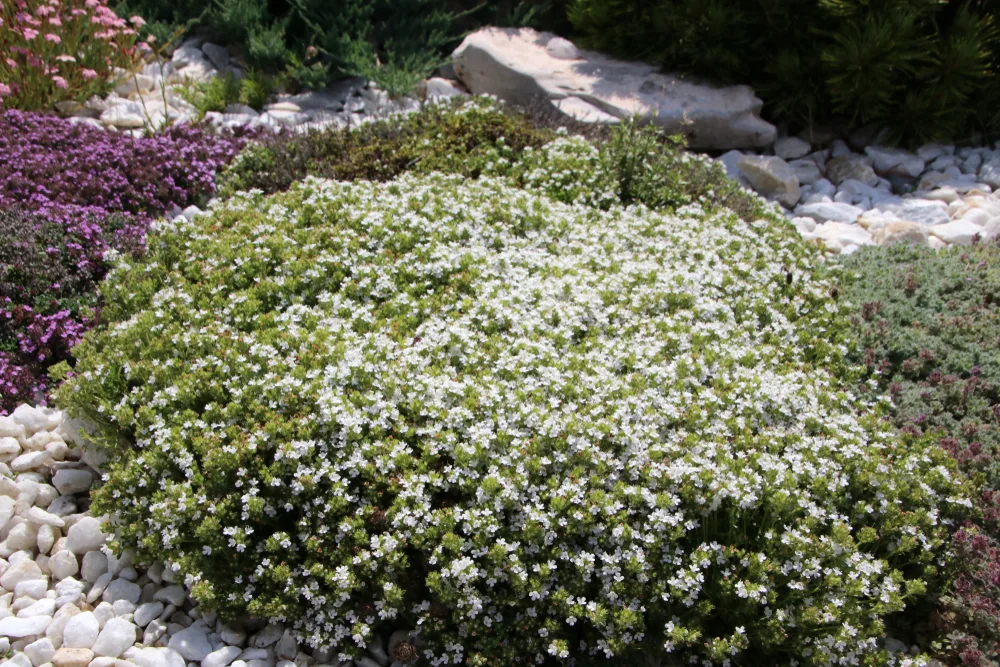
Wild thyme (Thymus serpyllum) is a dwarf shrub and creeper with a minty fragrance, though the leaves are rarely used in cooking. From June to July, it provides a stunning display of deep pink blossoms that completely overtake the green foliage.
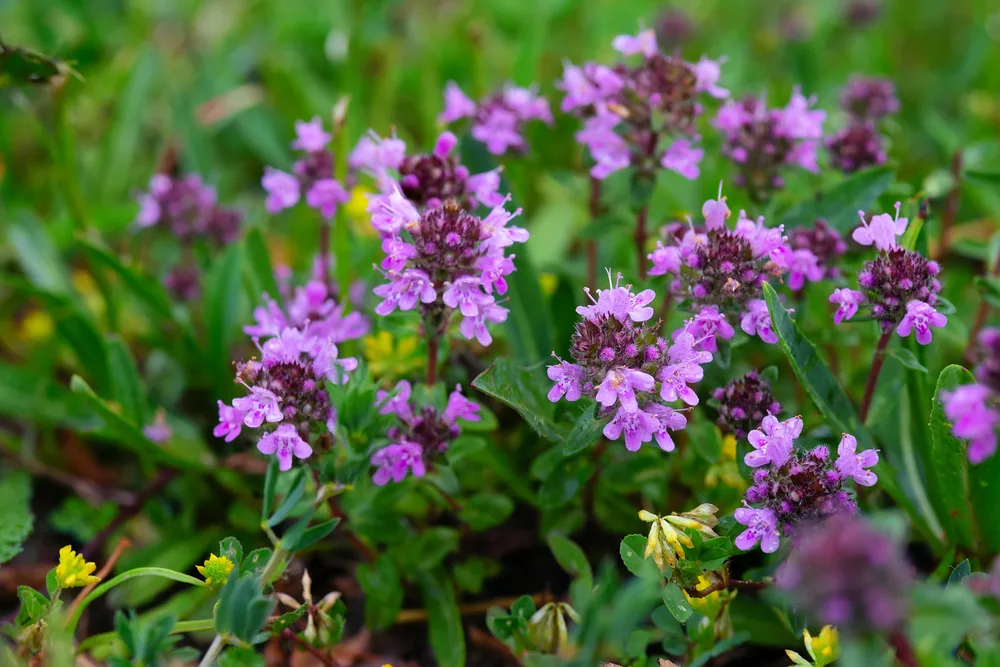
Thyme Growing Conditions:
Thyme is very easy to grow and has only two demands: lots of sun and good drainage.
Hardiness
Thyme is hardy in USDA zones 5 through 9.
Light Requirements
Plant thyme in a spot that receives full sun.
Soil
Thyme will grow best in conditions that mimic its homeland – loose, sandy, or rocky soils with excellent drainage.
Watering
Water your thyme plants sparingly – every other week or once per month depending on rainfall. Thyme is incredibly drought-tolerant and should only be given a drink when the soil is bone dry.
Fertilizer
Thyme is well adapted to nutrient starved soils and shouldn’t need any fertilizer throughout the growing season. That said, working a bit of compost into the soil at planting time won’t harm plants any and will provide them with an extra boost.
Pruning
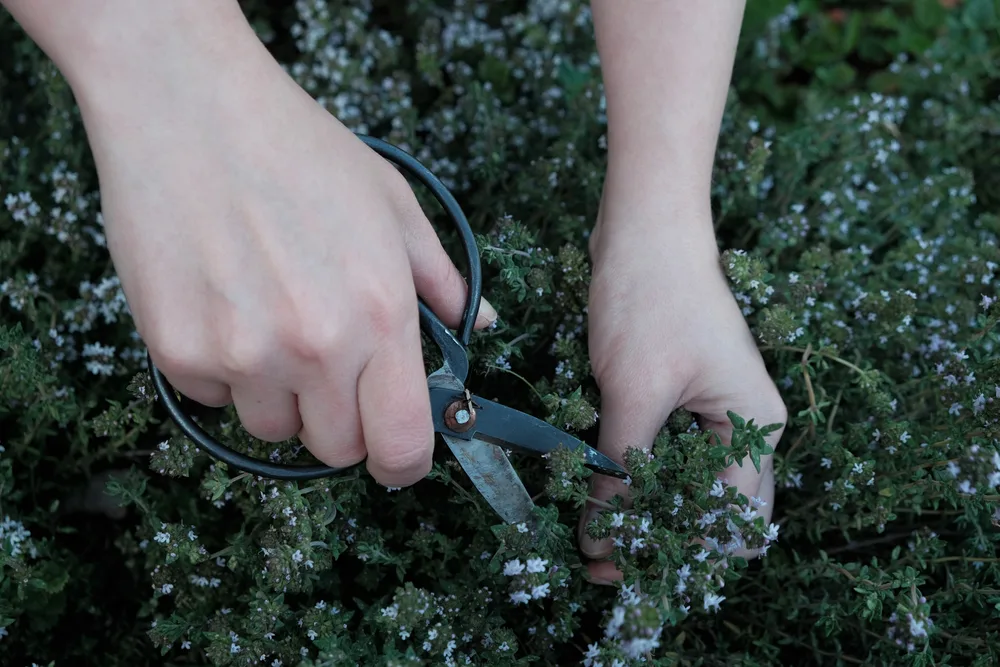
After several seasons, thyme has a tendency to become excessively woody and loosely branched. Every three years or so, severely cut back thyme plants in spring to encourage new tender growth.
Companion Plants
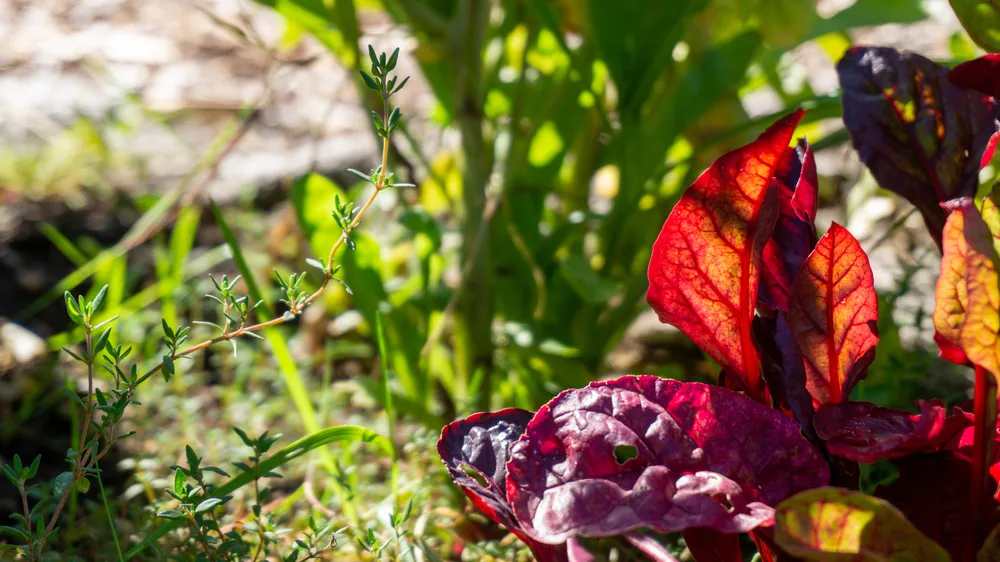
Thyme is a good friend to many other garden cultivars.
As a small flowered herb, it attracts hoverflies that will provide a check against aphids.
It improves the flavor of nearby eggplant, tomatoes, potatoes, and lettuce. When planted next to Brassicas, thyme boosts resistance to weevils, cabbage worms and cabbage loopers. It’s said that thyme planted next to strawberries will make them grow faster.
How to Grow Thyme
From Seed:
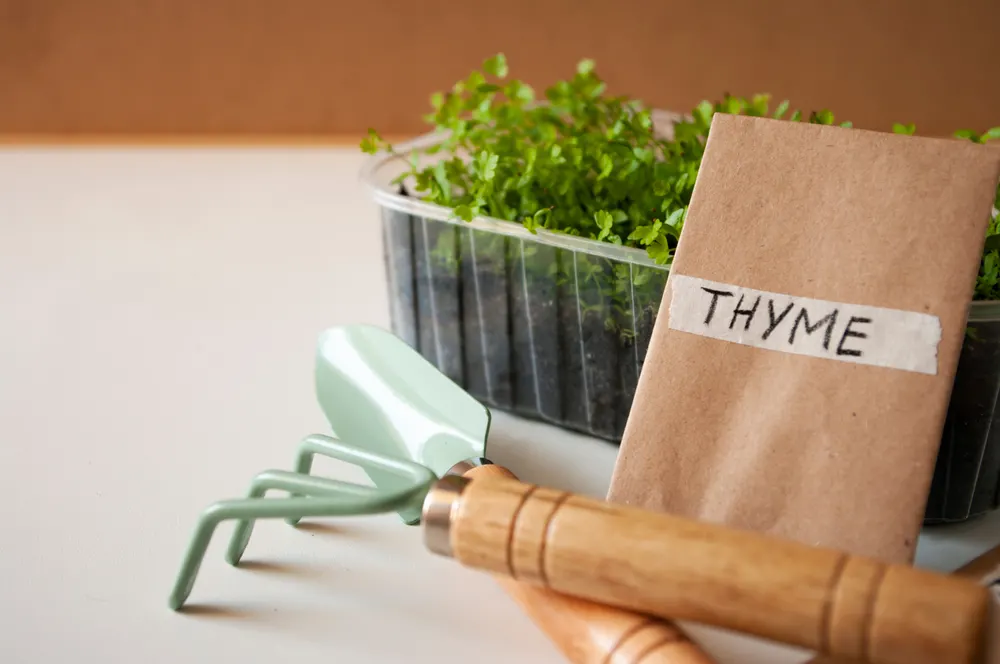
Growing thyme plants from seed can be something of a challenge because germination rates are spotty and the growth rate is quite slow.
Still, it absolutely can be done. You can sow seeds directly in the garden two weeks after the last frost date or give them an early start by sowing indoors in late winter.
- Loosely scatter seeds over the surface of moistened potting mix and cover with a very thin layer of soil.
- Place containers under bright light in a warm location. Optimum germination for thyme seeds is 60°F to 70°F (15°C to 21°C).
- Keep the soil just barely moist.
- Thyme seeds should begin to sprout in 2 to 3 weeks.
- When seedlings have their first set of true leaves, thin them to 4 to 6 inches apart.
- When seedlings are 2 to 3 inches tall, they can be hardened off and transplanted into the garden.
From Cuttings:
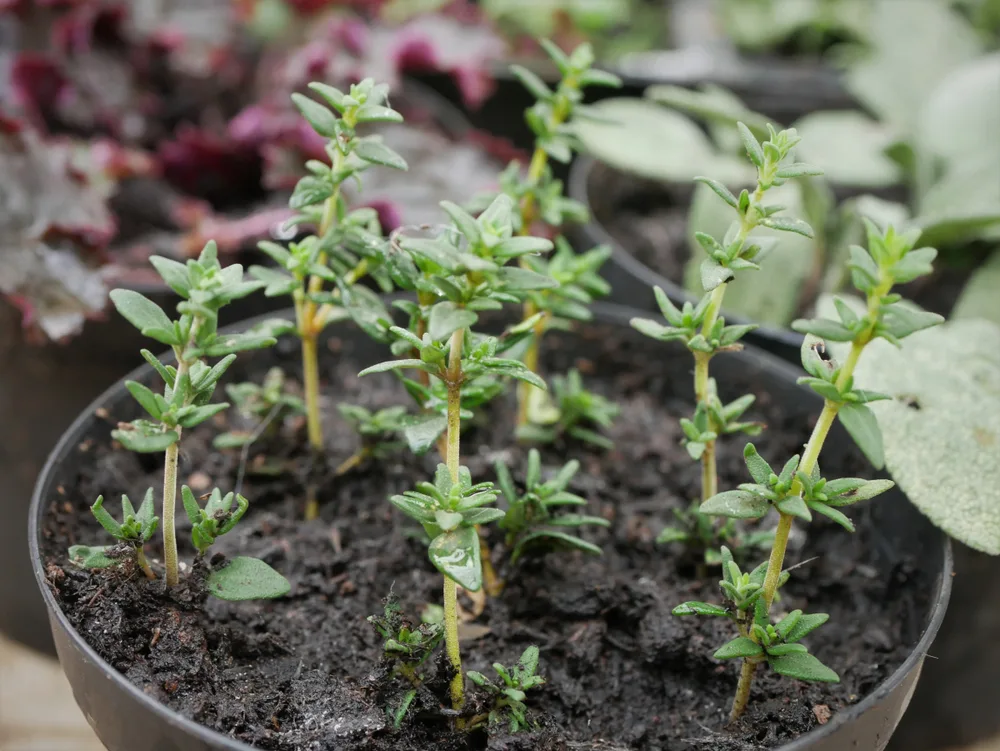
Taking cuttings from a healthy and established thyme plant is a more foolproof way to propagate this herb.
- Cut thyme branches in 3-inch lengths and remove all leaves from the lower half.
- Plant cuttings in sterile potting soil. Optionally, dip stems in a natural rooting hormone before sticking them in the soil to speed up the rooting process.
- Keep the soil moist but not too wet – thyme cuttings will rot if the soil is oversaturated.
- The thyme seedlings should be ready to be hardened off and transplanted to the garden in about 8 weeks.
From Division:
Another method to multiply your thyme collection is through root division.
- Divide thyme plants in spring.
- Select healthy and vigorous plants that are at least 3 years old.
- Starting about 5-inches out from the plant’s root system, dig up clusters of thyme plants with a shovel. Dig deeply enough to capture the roots.
- Gently separate individual plants from the clump by grasping the each main stem and pulling them apart. Thyme plants should split up easily but if they don’t, use your shovel to sever the root ball.
- Plant immediately in the garden, giving each new planting at least 1 foot of space to spread.
- Water each thoroughly to reduce transplant shock, but be careful not to overly wet the soil.
From Starter Plant:

Thyme will grow in temperatures between 39°F to 82°F (4°C to 28°C) but does its best at 61°F (16°C).
Once all risk of frost has passed and temperatures are mild, you can plant seedlings purchased from the store into the garden.
- Work some compost or leaf mold into the soil of your planting site to improve drainage.
- Dig a hole a little larger than the container the starter plant came in.
- Remove the thyme plant from the pot, and nestle it into the hole, maintaining the same planting depth as the container.
- Backfill with soil and gently tamp it down with your hands.
- Give starter plants a good drink to help them become established.
How to Harvest Thyme
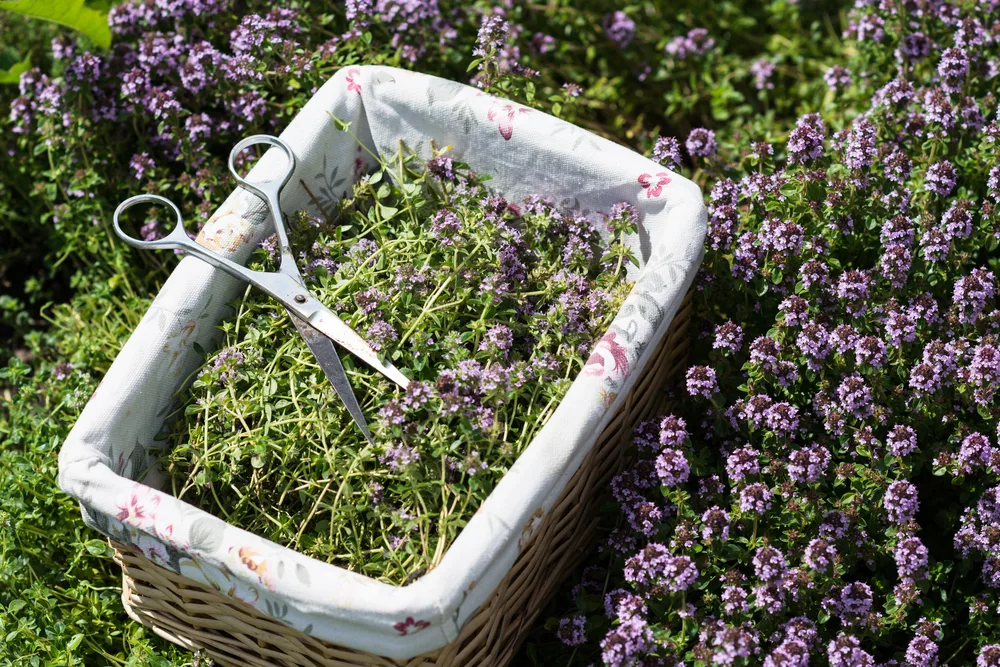
Allow your thyme plants to develop for one year (if not two) before taking your first harvest. You can take small samplings of leaves here and there, but it’s best to let your thyme plants settle in to their new home before cutting them back.
Once thyme plants are big and strong, they can be harvested from at any time during the growing season. The most fragrant leaves occur just before the plants begin to flower, when the aromatic oils in the foliage is at its highest.
Cut thyme sprigs 5 to 6 inches from the tender top growth of the plant, leaving the woody branches behind. A good rule is to always leave about 5 inches of old growth so the plant will better rejuvenate itself after a cutting.
Thyme leaves will retain a lot of their flavor through the entire season, even after plants have flowered. Allow plants to finish blooming before taking another helping. In the meantime, bees and other pollinators will gladly gorge themselves on the flower nectar.
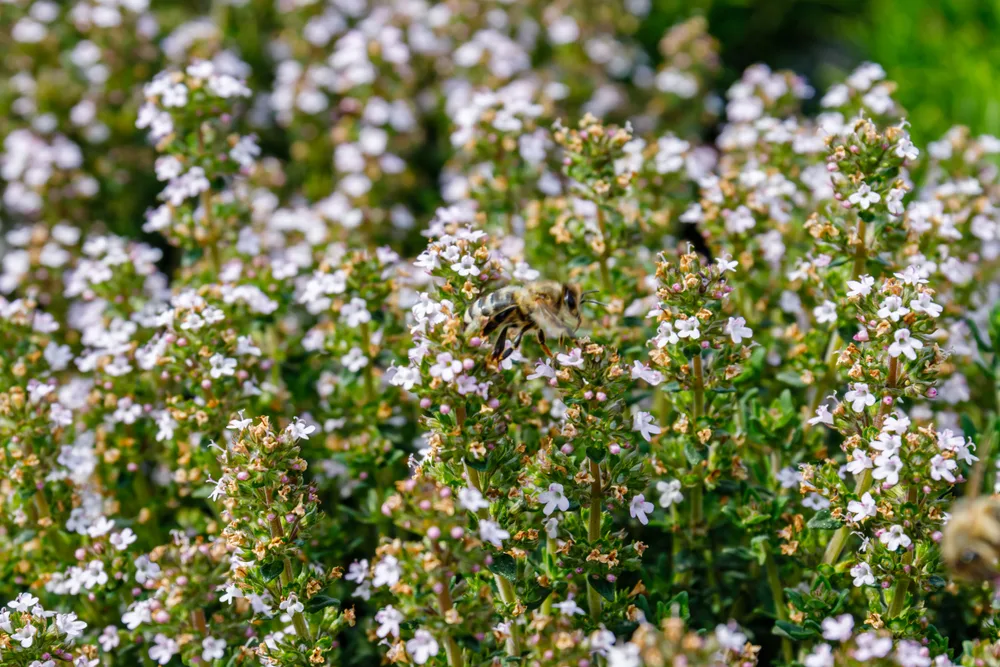
How to Store Thyme
Fresh or dried, this herb pairs exceedingly well with most fare – meats, fish, vegetables, marinades, sauces, soups, stews, casseroles, cocktails and teas.
Freshly clipped thyme sprigs can last in the fridge for several weeks.
To extend thyme’s freshness in the refrigerator, roll up the sprigs in a damp paper towel and place in a zippered baggie. Alternatively, set bunches of thyme in a jar and fill with about an inch of water before placing it in the fridge.
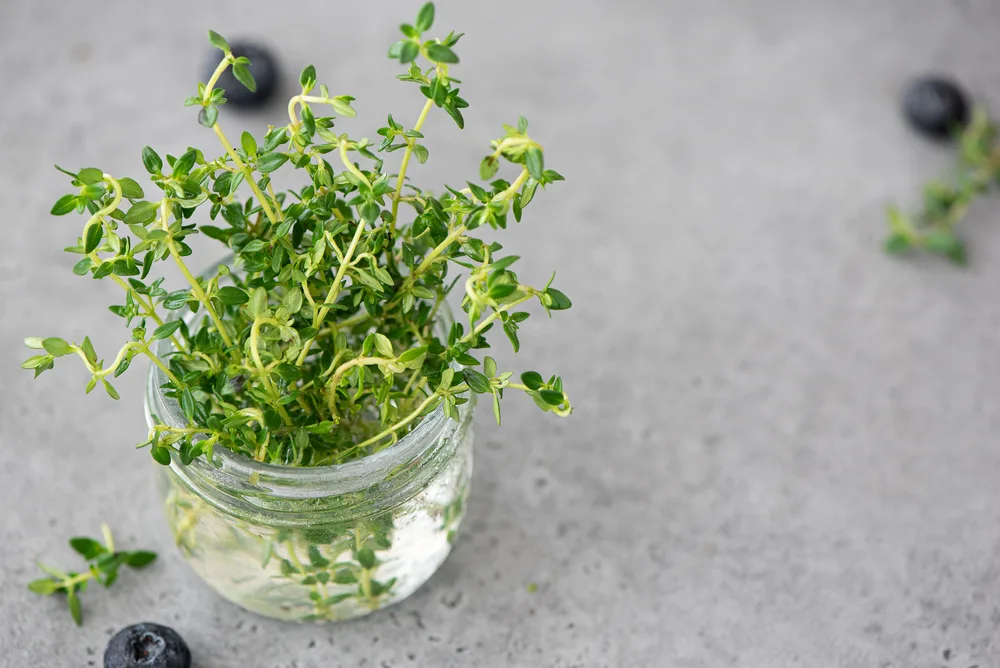
Freezing thyme is a great way to preserve it while maintaining full flavor. Put your thyme branches whole in a large zippered bag and set it in the freezer for a few hours. Once the leaves are brittle enough, it’s easy to strip them from the stem by running your fingers down the length.
Place thyme leaves in ice cube trays and fill with water. Set the tray in the freezer. When cubes are frozen, remove them from the tray and pop them into a freezer bag.
Thyme can also be prepped into thyme vinegar, thyme honey, and thyme oil to enhance the shelf life.
And of course, small bunches of thyme can be hung up to dry in a dark, warm, and ventilated area. When thoroughly dehydrated, strip leaves from the stems and store in a sealed container.
Related Reading: How To Dry Herbs At Home – Two Ways
Thyme Uses
Thyme can be added to almost any dish to enhance the flavor, but it can be used in many more ways than that. Take a look at our article sharing some of the best ways to use thyme that goes beyond sprinkling it on your chicken.
Thyme Seed Saving
When thyme plants are finished flowering, they produce dry “fruits” – or schizocarps – that each contain one or two seeds.
To collect thyme seeds, snip off flowering branches as soon as they start setting seeds. Hang them in small bunches upside down to dry for 2 to 3 weeks.
When flowers have dried completely, shake them in a paper bag to release the seeds. Separate the seeds from the chaff by sifting them with a mesh strainer.
Label and store your seeds in a sealed container and place in a cool and dry spot. Thyme seeds will be viable for 2 to 3 years.
Common Issues:
Thankfully, thyme is rarely bothered by insects or disease.
Thyme is somewhat susceptible to root rot when plants are overwatered and / or are planted in a site with poor drainage. This is easy enough to remedy by amending clay-heavy soils with compost to boost drainage and letting the soil dry completely between waterings.

Get the famous Rural Sprout newsletter delivered to your inbox.
Including Sunday musings from our editor, Tracey, as well as “What’s Up Wednesday” our roundup of what’s in season and new article updates and alerts.


